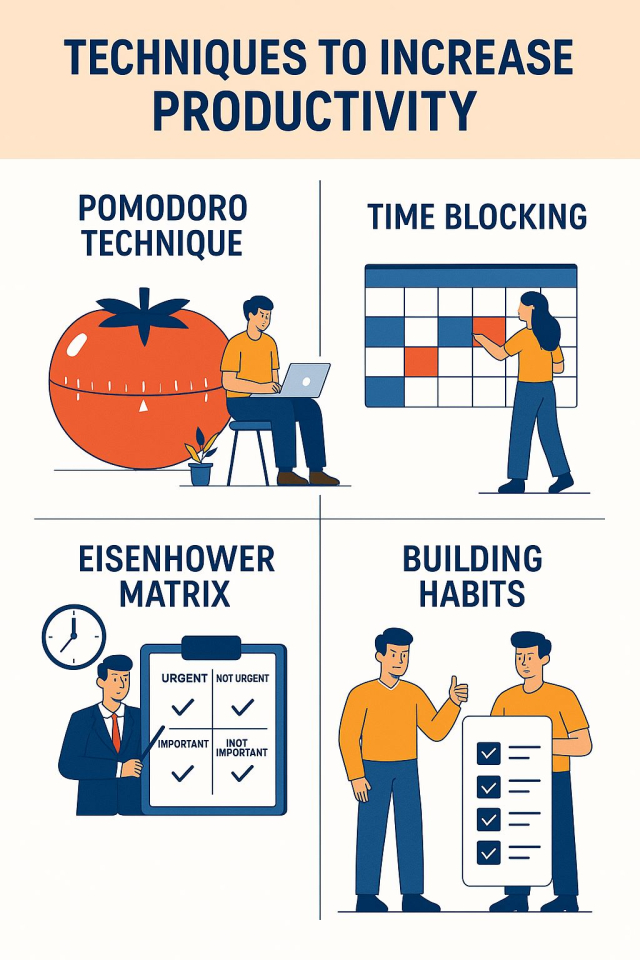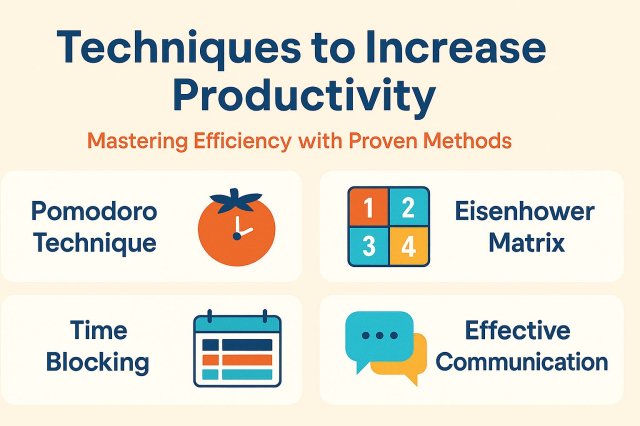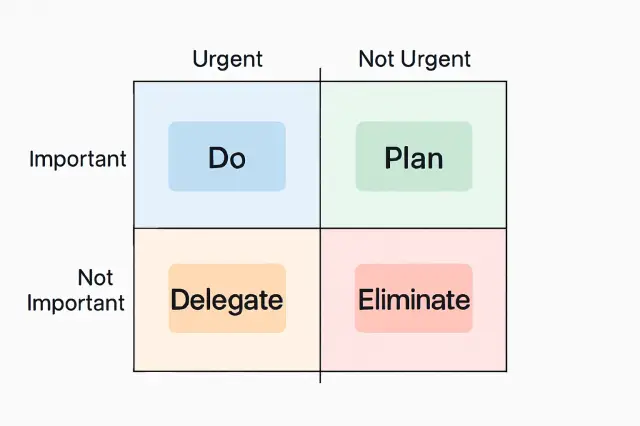Increasing productivity is essential in today's fast-paced workplace. Various techniques can help individuals and teams work more efficiently, resulting in better outcomes and job satisfaction. This article explores several effective methods to boost productivity, such as the Pomodoro Technique, time blocking, and the Eisenhower Matrix. Additionally, it addresses communication strategies and the importance of building productive habits (check our habit tracker).
Know here all our productivity calculators.
Importance of Productivity in the Modern Workplace
Productivity is a cornerstone of success in today's competitive work environment. The ability to optimize output affects not only individual performance but also the overall effectiveness of organizations.
Benefits of Increased Productivity
Enhanced productivity can lead to several significant advantages for both employees and organizations. These benefits include:
- Improved Performance: When productivity increases, employees often see a boost in performance metrics, which can translate into greater profitability for the company.
- Job Satisfaction: Higher productivity can contribute to a sense of accomplishment among employees, leading to increased job satisfaction and lower turnover rates.
- Professional Growth: Productive individuals have the opportunity to develop new skills and pursue career advancement, facilitating personal and professional growth.
- Cost Efficiency: Effective use of time and resources reduces operational costs, allowing companies to allocate funds to other strategic areas.
Challenges to Productivity
Despite the benefits, multiple challenges can hinder productivity in the workplace. Key obstacles include:
- Distractions: The modern workplace is filled with potential distractions, such as excessive meetings, interruptions from coworkers, and digital notifications.
- Time Management Issues: Many employees struggle with prioritizing tasks, leading to inefficient use of time and energy.
- Workplace Environment: An uninviting physical workspace can negatively impact morale and productivity. Factors like noise levels, lighting, and overall organization play a significant role.
- Lack of Clear Goals: Ambiguity in expectations and objectives can result in confusion among team members, which complicates task execution.
Measuring Productivity Success
To gauge productivity effectively, organizations must implement measurement systems. Understanding the metrics that define success includes:
- Performance Indicators: Key Performance Indicators (KPIs) are essential for monitoring the effectiveness of employees and teams. Examples include sales figures, project completion rates, and customer satisfaction scores.
- Regular Feedback: Continuous feedback mechanisms can help identify areas for improvement. Surveys and performance reviews facilitate open communication about productivity levels.
- Time Tracking: Utilizing time management tools that allow for the tracking of hours devoted to specific tasks can unveil patterns of productivity, guiding necessary adjustments.
- Benchmarking: Comparing internal metrics against industry standards can help organizations assess their productivity relative to competitors.
Effective Communication for Better Productivity
Effective communication serves as a foundation for improving productivity within teams. By fostering clear, concise, and open dialogue, organizations can enhance collaboration and streamline processes.
Methods to Enhance Team Communication
Communication methods can significantly impact how well a team functions. The following approaches can enhance team dynamics and enable successful project outcomes:
- Regular Check-ins: Scheduling brief, regular meetings allows team members to share updates and address any challenges.
- Clearly Defined Roles: Ensuring everyone understands their responsibilities can reduce confusion and promote accountability.
- Feedback Loops: Creating an environment where constructive feedback is encouraged helps in continuous improvement and builds trust among team members.
Overcoming Communication Barriers
Significant barriers can hinder effective communication in the workplace. Identifying and addressing these obstacles is crucial for maintaining productivity.
- Language Differences: In diverse teams, language barriers might occur. Encouraging the use of plain language and avoiding jargon can help bridge the gap.
- Cultural Differences: Awareness of different communication styles can enhance interactions. Offering cultural sensitivity training can promote understanding and collaboration.
- Remote Work Challenges: When teams are distributed, miscommunications can arise due to lack of non-verbal cues. Utilizing video conferencing tools can help convey tone and intent.
Tools for Improving Workplace Communication
Leveraging technology can further enhance communication effectiveness. Various digital tools offer solutions to streamline interactions and facilitate information sharing.
- Instant Messaging Platforms: Tools like Slack or Microsoft Teams allow for quick and efficient communication, reducing the time spent waiting for email responses.
- Project Management Software: Platforms such as Trello or Asana help keep everyone on the same page by providing visibility on task progress and deadlines.
- Video Conferencing Software: Tools like Zoom or Google Meet enable face-to-face communication, which can improve engagement and clarity during discussions.
Time Management Techniques to Boost Productivity
Effective time management is crucial for enhancing productivity. By implementing structured techniques, individuals and teams can achieve more in less time and alleviate stress. Below are several proven methods that can significantly improve productivity.

The Pomodoro Technique
The Pomodoro Technique is a time management method that enhances focus and efficiency. By breaking work into specific intervals, it encourages sustained concentration and mitigates burnout.
How to Implement Pomodoro
- Choose a task you want to work on.
- Set a timer for 25 minutes, the standard duration for one Pomodoro.
- Work on the task until the timer rings. Keep distractions at bay.
- Take a short break of about 5 minutes to refresh your mind.
- After completing four Pomodoros, take a longer break of 15-30 minutes.
Benefits of Taking Regular Breaks
Regular breaks are essential as they help to maintain mental agility. Short intervals for relaxation can lead to increased creativity and better problem-solving abilities. This approach not only enhances overall productivity but also contributes to long-term job satisfaction.
Time Blocking Planner
The time blocking technique involves assigning specific blocks of time for different activities throughout the day. This method allows for a more intentional approach to managing tasks.
Creating a Time Blocking Schedule
- List all tasks and categorize them based on priority.
- Allocate specific time slots for each task, ensuring all responsibilities are accounted for.
- Use calendar applications to visually map out the time blocks.
Prioritizing Tasks Using Time Blocks
Prioritization is key in time blocking. By focusing on high-priority tasks during peak productivity hours, individuals can maximize their efficiency. This ensures that critical tasks receive the attention they deserve, leading to better outcomes.
The Eisenhower Matrix
The Eisenhower Matrix is a decision-making tool that helps categorize tasks into four quadrants based on urgency and importance. It clarifies priorities and aids in effective time management.
Categorizing Tasks by Urgency and Importance
- Urgent and Important: Tasks that need immediate attention, such as deadlines or crises.
- Important but Not Urgent: Strategic tasks that contribute to long-term goals and can be scheduled.
- Urgent but Not Important: Tasks that can be delegated to others to free up time for more significant projects.
- Neither Urgent nor Important: Low-priority tasks that should be minimized or eliminated.
Making Decisions with the Eisenhower Matrix
By utilizing the Eisenhower Matrix, individuals can make informed decisions about where to invest their time and energy. This structured approach promotes productivity by focusing efforts on tasks that drive meaningful results.
Management Techniques to Enhance Team Productivity
Effective management techniques serve as the backbone of a productive team. By cultivating an environment focused on collaboration and empowerment, organizations can significantly enhance overall performance.
Fostering a Productive Team Environment
Creating a workspace that encourages productivity involves several tactics aimed at supporting team dynamics. A positive environment not only increases motivation but also fosters creativity. Key components include:
- Establishing clear goals and expectations: Clearly defined objectives help to keep team members focused on what needs to be achieved.
- Encouraging open communication: A culture of open dialogue allows team members to express ideas and concerns freely, which can lead to innovative solutions and improved teamwork.
- Providing necessary resources: Ensuring that teams have access to the tools and technology they need is crucial for efficiency.
Role of Leadership in Productivity
Leadership plays a pivotal role in shaping team productivity. Leaders must balance guiding the team with fostering individual autonomy. Effective leaders exhibit the following qualities:
- Visionary thinking: Leaders should communicate a clear vision that inspires and unites the team towards common goals.
- Supportive demeanor: By offering support and recognizing employee contributions, leaders can boost morale and commitment.
- Flexibility: Adapting management styles to meet the unique needs of team members can enhance engagement and productivity.
Building Autonomous and Motivated Teams
Encouraging autonomy is essential for cultivating motivated teams. When employees feel empowered to take ownership of their work, it translates to enhanced productivity. Steps to build autonomous teams include:
- Encouraging decision-making: Allowing team members to make decisions fosters a sense of ownership and accountability.
- Providing skill development opportunities: Investing in training and development helps employees expand their skill sets, which can lead to increased confidence and improved performance.
- Recognizing achievements: Celebrating individual and team accomplishments boosts morale and reinforces the value of hard work and collaboration.
In cultivating a productive work environment, management techniques play a crucial role in optimizing team dynamics. By focusing on effective communication, supportive leadership, and fostering autonomy, organizations can elevate their team's performance to new heights.
Utilizing Digital Tools for Improved Productivity
Digital tools have revolutionized the way individuals and teams approach productivity. Embracing the right software can streamline workflows, enhance collaboration, and provide insights into performance.
Task Management Software
Task management software helps individuals and teams organize responsibilities and prioritize tasks effectively. These tools enable users to break down large projects into manageable tasks, assign responsibilities, and set deadlines, which can lead to increased efficiency.
- Popular task management tools include Asana, Trello, and Monday.com and the same Calcualtorr.com. These platforms offer features like boards, lists, and timelines to visualize progress.
- By centralizing project tasks, teams can easily track who is responsible for what and monitor upcoming deadlines.
- Many task management tools come with mobile apps, ensuring accessibility on the go, which is crucial for remote teams.
Calendar and Scheduling Apps
Effective time management often begins with good scheduling practices. Calendar and scheduling apps are essential for organizing meetings, planning tasks, and blocking out time for focused work.
- Tools like Google Calendar and Microsoft Outlook allow users to share availability, making it easier to schedule meetings without excessive back-and-forth communication.
- By integrating to-do lists with calendar apps, users can create a holistic view of their tasks and commitments.
- Features like reminders and alerts help ensure that important deadlines and meetings are not overlooked.
Insightful Tools for Tracking Progress
Tracking progress is vital for understanding productivity levels and identifying areas for improvement. Insightful tools analyze performance data, offering valuable insights to enhance productivity.
- Tools such as Harvest and Toggl allow users to track the time spent on different tasks and projects, providing a clear view of where time is allocated.
- Reports generated from these tools help in recognizing patterns in productivity, such as peak efficiency times and recurring distractions.
- These insights can lead to informed decisions about workflow adjustments, ultimately fostering a more productive work environment.
Building Productive Habits for Long-term Success
Establishing productive habits is crucial for sustaining long-term success and enhancing overall productivity. These habits create a foundation that supports consistent performance and growth.
Identifying and Changing Unproductive Habits
Recognizing unproductive habits is the first step towards fostering better work practices. Common unproductive behaviors include procrastination, excessive multitasking, and poor time management. By identifying these patterns, individuals can take actionable steps to modify them.
- Self-assessment: Regularly assessing daily activities helps in pinpointing habits that hinder efficiency.
- Tracking time: Keeping a record of how time is spent during the day can reveal areas that require improvement.
- Setting specific goals: Establishing clear and achievable goals can lend focus and reduce distractions.
Once unproductive habits have been identified, strategies to change them may include adopting a structured schedule, employing time management techniques, and utilizing tools to maintain accountability.
Establishing a Routine for Increased Focus
A well-defined routine can enhance focus and efficiency. Creating a daily schedule that outlines specific times for tasks contributes to better time management.
- Morning rituals: Incorporating effective rituals, such as exercise or meditation, can set a positive tone for the day.
- Blocking time for tasks: Allocating fixed time blocks for concentrated work minimizes distractions.
- Review and adjust: Regularly assessing the effectiveness of the routine allows for necessary adjustments.
Consistency is critical in establishing a routine. Over time, a reliable structure leads to enhanced concentration and reduces the mental load associated with planning each day.
Incorporating Healthy Habits into Your Day
Integrating healthy habits is essential for maintaining both physical and mental well-being, which directly influences productivity levels. Simple adjustments can lead to significant improvements in energy and focus.
- Balanced diet: Eating nutrient-rich foods promotes sustained energy levels throughout the day.
- Regular physical activity: Engaging in exercise boosts mood and cognitive function, enhancing productivity.
- Staying hydrated: Adequate water intake is vital for maintaining concentration and overall health.
In addition, taking regular breaks to recharge the mind can prevent burnout, thus sustaining higher levels of productivity. By creating a holistic approach that combines routine, healthy practices, and productivity, individuals can achieve a sustainable performance that fosters success over time.




